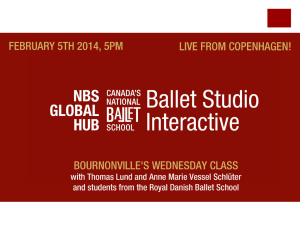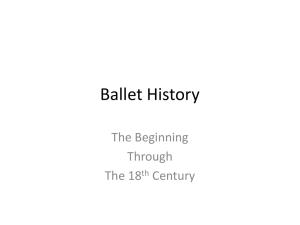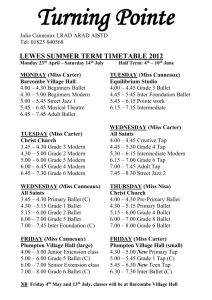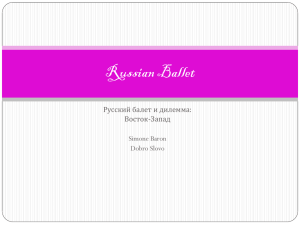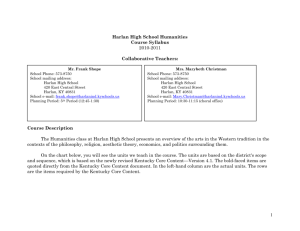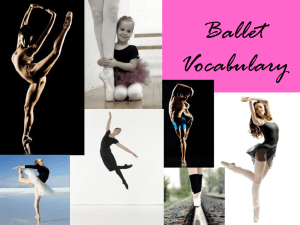Arts Courses
advertisement
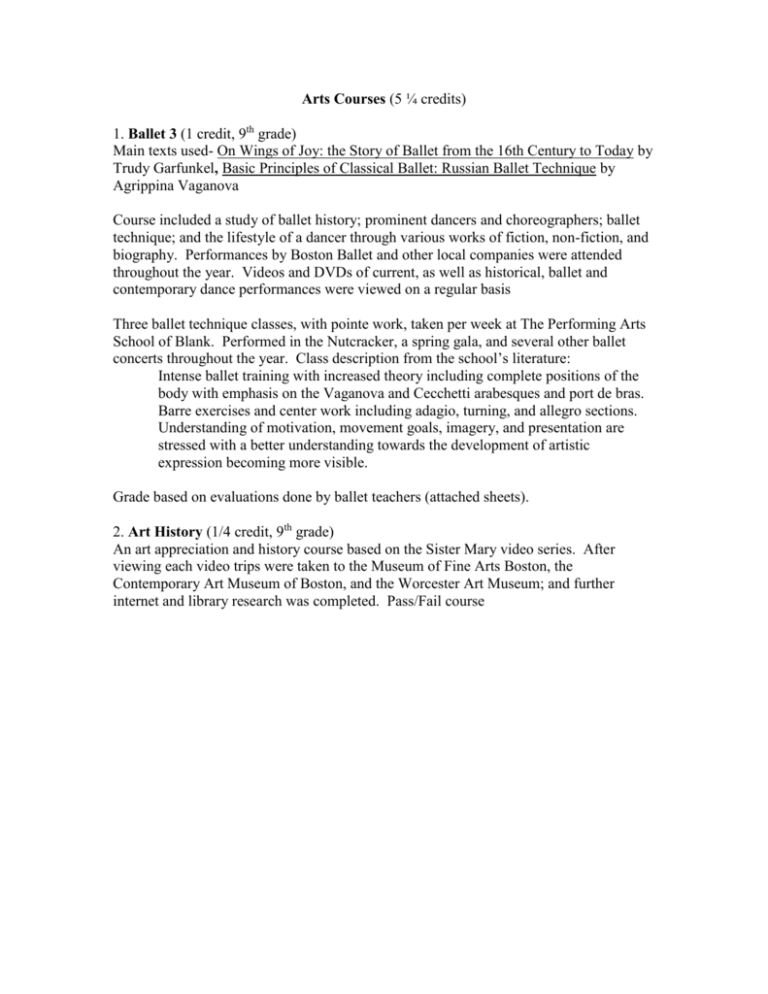
Arts Courses (5 ¼ credits) 1. Ballet 3 (1 credit, 9th grade) Main texts used- On Wings of Joy: the Story of Ballet from the 16th Century to Today by Trudy Garfunkel, Basic Principles of Classical Ballet: Russian Ballet Technique by Agrippina Vaganova Course included a study of ballet history; prominent dancers and choreographers; ballet technique; and the lifestyle of a dancer through various works of fiction, non-fiction, and biography. Performances by Boston Ballet and other local companies were attended throughout the year. Videos and DVDs of current, as well as historical, ballet and contemporary dance performances were viewed on a regular basis Three ballet technique classes, with pointe work, taken per week at The Performing Arts School of Blank. Performed in the Nutcracker, a spring gala, and several other ballet concerts throughout the year. Class description from the school’s literature: Intense ballet training with increased theory including complete positions of the body with emphasis on the Vaganova and Cecchetti arabesques and port de bras. Barre exercises and center work including adagio, turning, and allegro sections. Understanding of motivation, movement goals, imagery, and presentation are stressed with a better understanding towards the development of artistic expression becoming more visible. Grade based on evaluations done by ballet teachers (attached sheets). 2. Art History (1/4 credit, 9th grade) An art appreciation and history course based on the Sister Mary video series. After viewing each video trips were taken to the Museum of Fine Arts Boston, the Contemporary Art Museum of Boston, and the Worcester Art Museum; and further internet and library research was completed. Pass/Fail course 3. Introduction to Music Theory, History, and Industry (1 credit, 10th grade) Texts Used- Singing for the Stars: A Complete Guide to Training Your Voice by Seth Riggs, John W. Schaum: Notespeller Book 1, Men of music: Their Lives, Times, and Achievements by Wallace Brockway & Herbert Weinstock, The Music Business by David Naggar, So You Wanna Be a Rock Star: How to Create Music by Stephen Anderson, Opera 101: A Complete Guide to Learning and Loving Opera by Fred Plotkin The following topics were covered on an introductory level: -The biological aspects of singing -Music history -Classical and jazz music appreciation The following topics were covered on an in depth level: -Vocal technique and performance of jazz standards and modern pop songs - Music theory -Musical composition (through personal composition and the study of modern and historical composers) -Music industry Additional books, CDs and periodicals were used as supplementary materials throughout the year. Voice lessons (1 hour per week, and completion of weekly work assigned by the teacher) were taken at Rob’s Music Company. Twelve concerts by various artists (generally from the folk, jazz, choral or classical genres) were attended throughout the year. Pass/fail course 4. Ballet 4 (1 credit, 10th grade) See course, text, and grading description for Ballet 3. Four ballet technique classes, with pointe work, taken per week at The Performing Arts School of Blank. Performed in the Nutcracker, a spring gala, and several other ballet concerts throughout the year. Class description from the school’s literature: Strengthening all of the work of the previous level. The plasticity, coordination, smooth connection of the arms, legs, feet, and head are the primary developmental goals. Rhythmic patterns are emphasized and attention is given to aiding the dancer’s ability to “tune in” to muscular feelings. Petite allegros with beats are introduced, and grande allegro & pirouettes are stressed. Body placement and the proper use of port de bras are essential. 5. Ballet 5 (1 credit, 11th grade) See course, text, and grading description for Ballet 3. Five ballet technique classes, with pointe work, taken per week at The Performing Arts School of Blank. Performed in the Nutcracker, a spring gala, and several other ballet concerts throughout the year. Class description from the school’s literature: Emphasis placed on greater stability and complexity in study of adagio developing smooth, graceful, and supple movements passing from one position to another; various turns, in various ways, turning in the open poses are part of daily class. Study and mastery of technique in battu and petite allegro, which will in turn facilitate the development of elevation in grande allegro. Regular and repeated reference will be made at this level to what has already been learned to begin the process of “fine tuning” the dancer’s movement and understanding of movement and how to self correct. The combinations grow more complex as the tempos become more difficult. 6. Ballet 6 (1 credit, 12th grade) See course, text, and grading description for Ballet 3. Five ballet technique classes, with pointe work, taken per week at The Performing Arts School of Blank. Performed in the Nutcracker, a spring gala, and several other ballet concerts throughout the year. Class description from the school’s literature: Dancers will focus on clean technique, speed, strength, endurance, and musicality. During this year study of jumps in various ways increases along with the increased complexity of jumping combinations with beats being performed at a quick tempo. Work intensifies on development of ballon (light, elastic quality of jumping). Dancers are gaining an increased understanding of the kinesthetic dynamics that underlie their developing technique. Fundamental movements, done with aplomb and virtuosity, are carried through with finishing touches, revealing the perfection of classical dance in this year of training. Adagio develops to allegro; pirouettes move to allegro; steps of elevation emerge from pirouettes (or the reverse). Use of space is emphasized and length of combinations is increased to develop stamina. Everything is working towards a truly finished look for a dancer- stressing confident virtuosity and a mastery of technique so that the dancer’s artistry can mature and develop.
